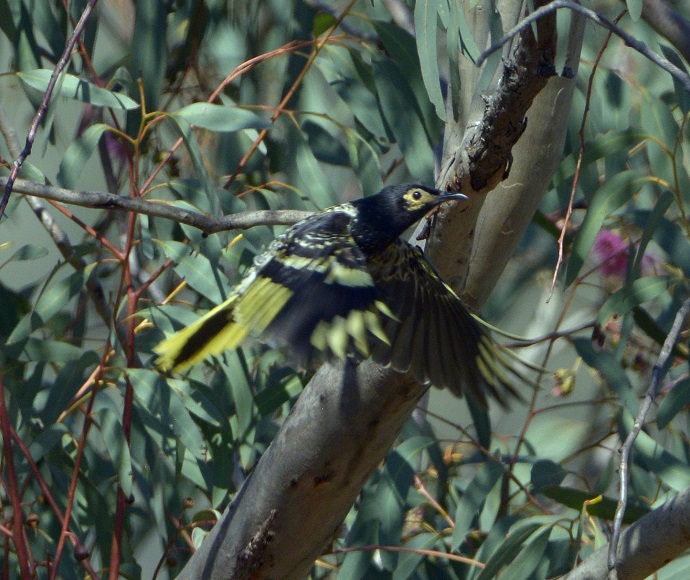More than just a striking songbird, the critically endangered regent honeyeater is essential to the health of inland south-east Australian forests.
Thousands of these nomadic pollinators once contributed to the genetic diversity of favoured food trees, including eucalypts, across Victoria, New South Wales and Queensland. However, the number of regent honeyeaters (Anthochaera phrygia) has fallen due to loss of habitat and competition from over-abundant noisy miners.
This species is now so rare that the young are mimicking the songs of other species, with their own voice at risk of disappearing forever.
Partners are the key to success
The Saving our Species program has been leading the regent honeyeater conservation project, working in partnership with BirdLife Australia and Taronga Conservation Society Australia.
The project has seen the release of 140 zoo-bred birds in New South Wales. With as few as 250 to 300 regent honeyeaters estimated to remain in the wild, every successful breeding and release event is critical.
‘Taronga brings an extensive skillset in husbandry, veterinary, and conservation science to the recovery program. Partnerships, such as the one between Taronga and Saving our Species, are critical to the successful outcome of recovery programs,’ said Taronga Wildlife Conservation Officer Monique Van Sluys.
Kim Maute, Principal Ecologist, Saving our Species, says all partners are committed to science-informed actions that will slow the rate of decline for wild regent honeyeaters and improve the population trajectory.
BirdLife Australia and the Australian National University recently discovered wild birds nesting in the Capertee Valley region, a sight unseen for more than 5 years. Over a dozen nests and at least 16 fledglings were observed, including 3 chicks raised by a zoo-bred female and wild male pair. The chicks are the first confirmed zoo-wild offspring from the NSW regent honeyeater recovery program.
Read the full story at Wild success for the regent honeyeater breeding program.
Mick Roderick, Regent Honeyeater Recovery Coordinator, BirdLife Australia, says recovery coordination is all about collaboration, as it’s not something that can be achieved by one organisation alone.
‘Working together with such a diverse range of partners, including the community, has been inspiring, and we look forward to the next phases of the project as we reverse the decline of this unique Australian “jewel of the woodlands”,’ said Mick Roderick.
Through collaborative action, we can create a sustainable future for the regent honeyeater and ensure the survival of this magnificent species for generations to come.
Actions for further success
- Monitoring is essential for detecting any changes in population numbers and for finding nesting sites and can be achieved through large-scale bird surveys or by citizen scientists reporting sightings. Report sightings to BirdLife Australia.
- Breeding programs and the release of zoo-bred birds help bolster the wild population, while the protection of regent honeyeater habitat and nests helps promote their success.
- Partners can get involved by participating in bird surveys or funding priority conservation actions like monitoring programs, nest protection, captive breeding and community engagement to help continue this amazing work.

The critically endangered regent honeyeater (Anthochaera phrygia)
Learn more
Explore what your organisation can do to help protect this critically endangered bird and be part of an incredible conservation story.
By partnering to save the regent honeyeater, you can gain access to impactful engagement and behind-the-scenes opportunities like expert talks and on-Country experiences.
Contact the Saving our Species Partnerships Team today to start a conversation about the conservation of the regent honeyeater.
Contact us
Saving our Species partnerships
Email: [email protected]
Stay in touch
- Subscribe to the partnerships newsletter.
- Follow us on Facebook, Instagram, YouTube, LinkedIn or X.
- Search the Public register of Saving our Species conservation strategies.